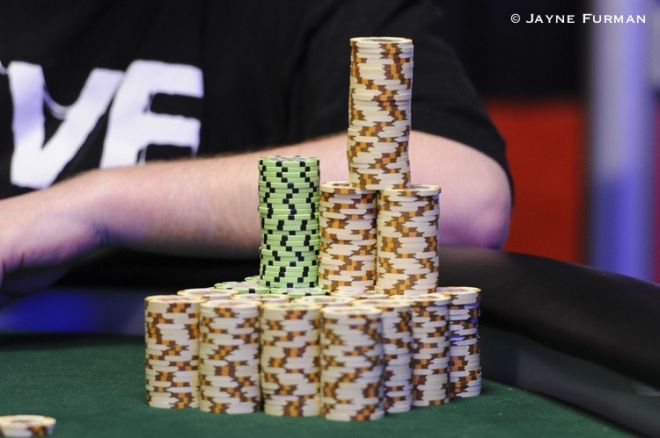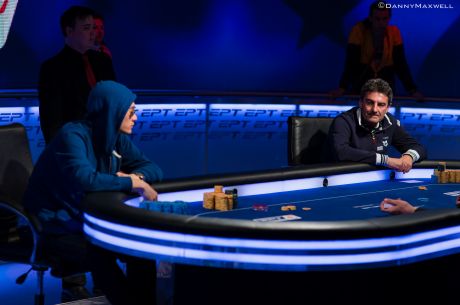What��s the Hurry? Recognizing Room for Play When Deep-Stacked

Last summer I was on hand to help cover the CPPT Choctaw Main Event at the Choctaw Resort Casino in Durant, Oklahoma. After the field had been whittled down to the final two competitors, an interesting heads-up hand took place between Gary Luther and Austin Lewis that ultimately helped to decide the fate of the tournament.
This hand was a turning point in play and gave what many times would have been a very long heads-up match a rather quick conclusion. It also illustrated an important lesson in tournament poker about the relationship between stack sizes and blinds and recognizing when deeper stacks can allow for more postflop play.
The Hand
The blinds were 30,000/60,000 with a 5,000 ante. Lewis had begun heads-up play with the lead, but after about 10 hands Luther had the edge with 6.675 million to the 5.275 million of Lewis.
Action began with Luther opening his button with a min-raise to 120,000. Lewis peeked at his cards in the big blind and announced he was reraising to 275,000. Luther then came over the top with a four-bet to 600,000, prompting Lewis to five-bet his hand to 1 million total.
Luther thought for a while then said he was all in, and Lewis instantly called. The hands were turned over.
Lewis: A?A?
Luther: 9?9?
Lewis was in a dominating position with his two aces and they held up through the 5?A?8?4?8? board. Lewis doubled to 10.55 million while Luther dropped to just 1.4 million. Just a few hands later, Luther was eliminated as the runner-up and Lewis was crowned the champion and winner of over $183,000 in first-place prize money.
Determining When You��re Deep
This hand is a prime example of a player failing to recognize how much room for play there was given the players�� current stack sizes.
First, let��s examine exactly where Luther and Lewis stood with regard to the blinds and antes. There were 11.95 million total chips in play and the blinds were at 30,000/60,000. This meant that there was just a little less than 200 big blinds in play. Luther began the hand with the chip lead and 6.675 million or approximately 111 big blinds, while Lewis had 5.275 million or approximately 87 big blinds.
These figures show that the two were remarkably deep-stacked prior to this hand. With the tournament structure providing 60-minute levels, the two had a lot of room to maneuver without having to push all in before the flop. Having so many blinds meant that the players should have been able to see more flops and play a match that involved more postflop play.
More Play Means More Patience
But what does that mean exactly �� to have more ��play��? If the two players had fairly shallow stacks heads-up �� say of 20 big blinds each �� then the value of each individual big blind would be worth more. Each hand would suddenly become more important from the start, as doing something as simple as taking down a pot with a raise-and-take from the button would significantly increase your stack size and allow you to lean on your opponent that much more.
That is to say, in a shallow-stacked heads-up scenario, more of the action would necessarily occur before the flop as the competitors simply would not have enough chips to make moves and battle it out postflop.
That wasn��t the case for Lewis and Luther, however. Their stack sizes were very large and the two had the option to see lots of community cards. Unfortunately for Luther, he didn��t recognize this and instead put his emphasis on playing a large pot before the flop.
By essentially turning his pocket nines into a bluff with the six-bet shove, Luther was correct in assuming that Lewis would certainly have to have a strong hand to call. The trouble lies in the times that his opponent does wake up with a hand with which he could call. After witnessing perceived strength from Lewis with both a three-bet and a five-bet (the first five-bet of the heads-up match), it was very likely for Lewis to be holding a hand better than Luther��s 9?9?.
Interestingly enough, if Luther had merely called Lewis��s five-bet to 1 million and then folded on the flop, he��d still be left with 94 big blinds and plenty of room for play.
Conclusion
Ultimately, Luther didn��t recognize exactly where each player��s stack stood in relation to the blinds and antes in this heads-up match. By choosing to play a large pot before the flop, Luther ended up risking a ton of footing in what was a very deep-stacked match. Because of this decision, Luther was eventually forced to settle for a runner-up finish just shy of the glory.
Want to stay atop all the latest in the poker world? If so, make sure to get PokerNews updates on your social media outlets. Follow us on Twitter and find us on both Facebook and Google+!








